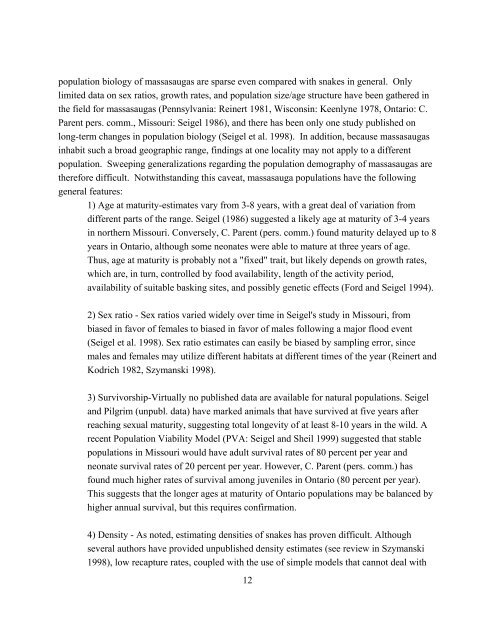The Eastern Massasauga Rattlesnake: - U.S. Fish and Wildlife Service
The Eastern Massasauga Rattlesnake: - U.S. Fish and Wildlife Service
The Eastern Massasauga Rattlesnake: - U.S. Fish and Wildlife Service
Create successful ePaper yourself
Turn your PDF publications into a flip-book with our unique Google optimized e-Paper software.
population biology of massasaugas are sparse even compared with snakes in general. Only<br />
limited data on sex ratios, growth rates, <strong>and</strong> population size/age structure have been gathered in<br />
the field for massasaugas (Pennsylvania: Reinert 1981, Wisconsin: Keenlyne 1978, Ontario: C.<br />
Parent pers. comm., Missouri: Seigel 1986), <strong>and</strong> there has been only one study published on<br />
long-term changes in population biology (Seigel et al. 1998). In addition, because massasaugas<br />
inhabit such a broad geographic range, findings at one locality may not apply to a different<br />
population. Sweeping generalizations regarding the population demography of massasaugas are<br />
therefore difficult. Notwithst<strong>and</strong>ing this caveat, massasauga populations have the following<br />
general features:<br />
1) Age at maturity-estimates vary from 3-8 years, with a great deal of variation from<br />
different parts of the range. Seigel (1986) suggested a likely age at maturity of 3-4 years<br />
in northern Missouri. Conversely, C. Parent (pers. comm.) found maturity delayed up to 8<br />
years in Ontario, although some neonates were able to mature at three years of age.<br />
Thus, age at maturity is probably not a "fixed" trait, but likely depends on growth rates,<br />
which are, in turn, controlled by food availability, length of the activity period,<br />
availability of suitable basking sites, <strong>and</strong> possibly genetic effects (Ford <strong>and</strong> Seigel 1994).<br />
2) Sex ratio - Sex ratios varied widely over time in Seigel's study in Missouri, from<br />
biased in favor of females to biased in favor of males following a major flood event<br />
(Seigel et al. 1998). Sex ratio estimates can easily be biased by sampling error, since<br />
males <strong>and</strong> females may utilize different habitats at different times of the year (Reinert <strong>and</strong><br />
Kodrich 1982, Szymanski 1998).<br />
3) Survivorship-Virtually no published data are available for natural populations. Seigel<br />
<strong>and</strong> Pilgrim (unpubl. data) have marked animals that have survived at five years after<br />
reaching sexual maturity, suggesting total longevity of at least 8-10 years in the wild. A<br />
recent Population Viability Model (PVA: Seigel <strong>and</strong> Sheil 1999) suggested that stable<br />
populations in Missouri would have adult survival rates of 80 percent per year <strong>and</strong><br />
neonate survival rates of 20 percent per year. However, C. Parent (pers. comm.) has<br />
found much higher rates of survival among juveniles in Ontario (80 percent per year).<br />
This suggests that the longer ages at maturity of Ontario populations may be balanced by<br />
higher annual survival, but this requires confirmation.<br />
4) Density - As noted, estimating densities of snakes has proven difficult. Although<br />
several authors have provided unpublished density estimates (see review in Szymanski<br />
1998), low recapture rates, coupled with the use of simple models that cannot deal with<br />
12

















